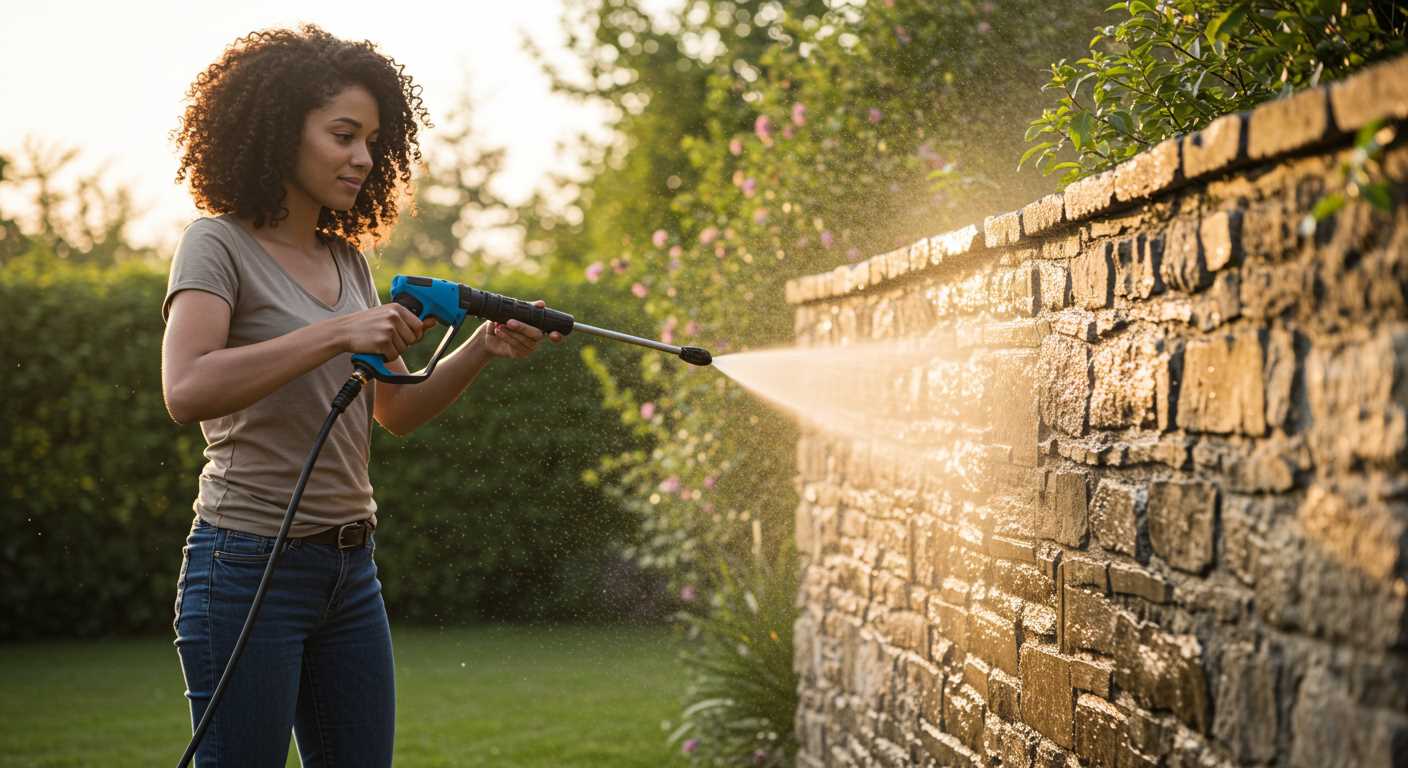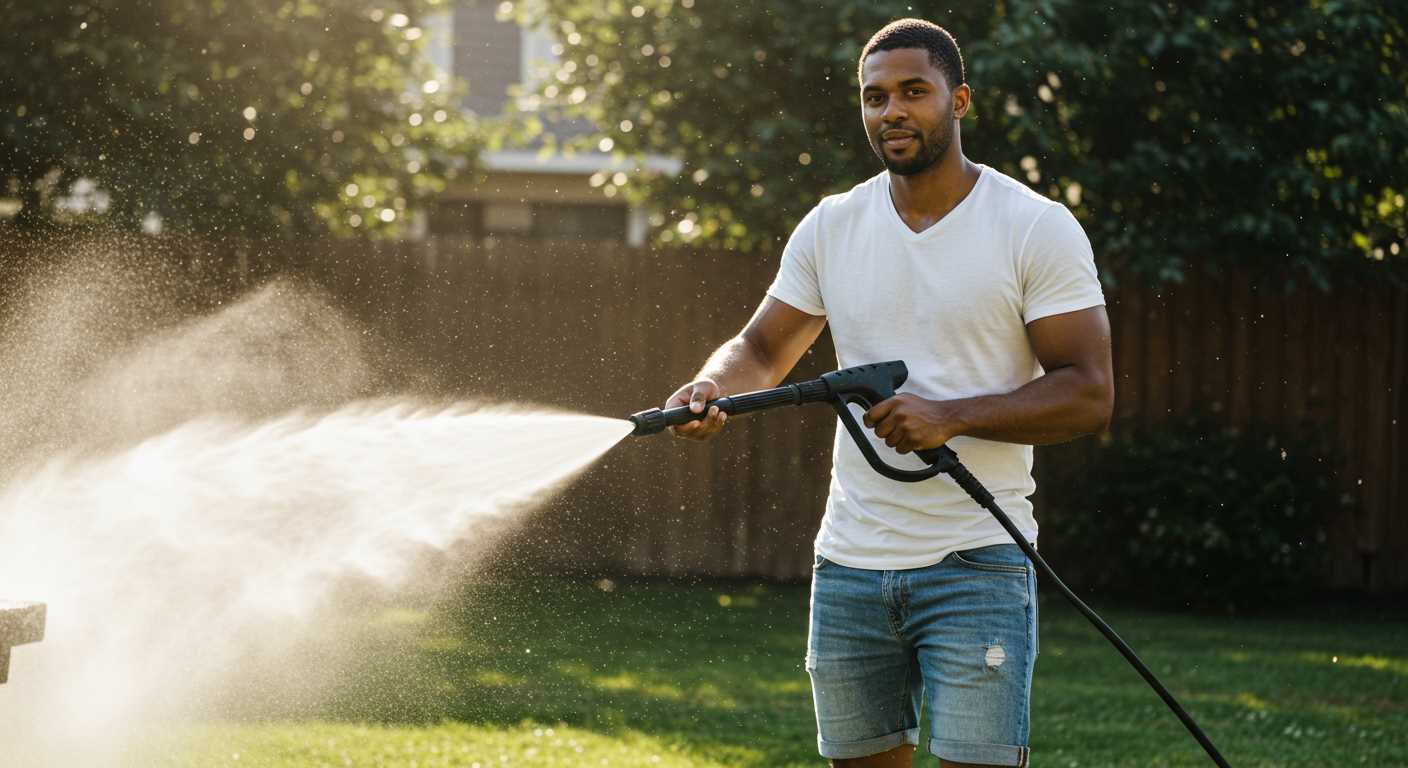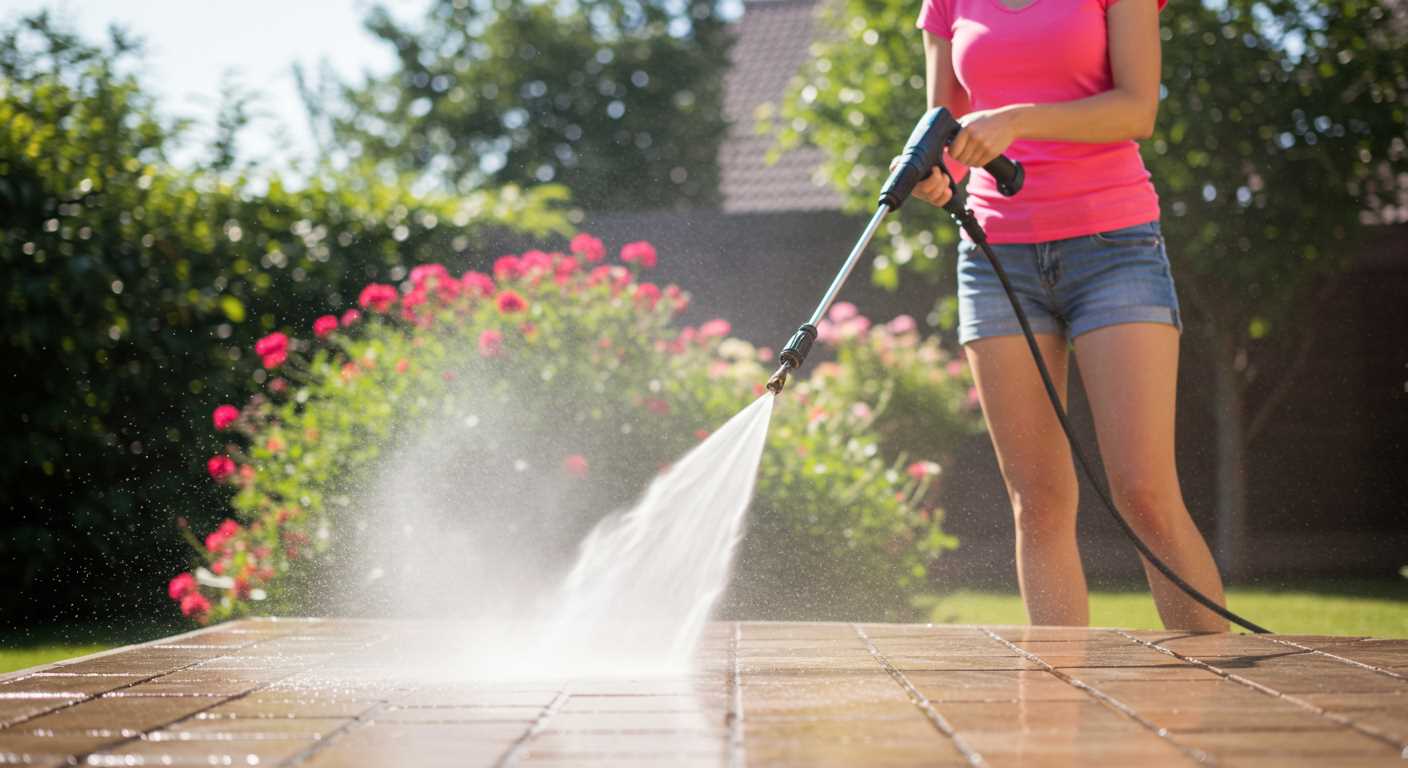



For effective maintenance of hard surfaces like bricks or concrete, I recommend using a unit that delivers between 2000 and 3000 pounds per square inch (psi). This range strikes a balance between power and safety, preventing damage while ensuring all debris is removed efficiently.
Consider functionality beyond just the pressure level. A machine equipped with a rotating nozzle can vastly improve performance by concentrating water flow on tough stains and grime. The right nozzle selection can also make a significant difference–use a 15-degree or 25-degree setting for optimal penetration without risking surface integrity.
When using this equipment, maintain a distance of approximately 12 to 18 inches from the surface to avoid chipping or etching. Work in sections, overlapping your strokes slightly to ensure a uniform finish. Don’t underestimate the effectiveness of a pre-treatment with detergent designed for outdoor cleaning, as it aids in loosening stubborn dirt and grime.
Choosing the Right PSI for Different Paver Materials

For concrete slabs, a machine delivering between 2,500 and 3,500 psi is ideal. This range effectively removes stubborn dirt and grime without damaging the surface.
For natural stone, such as slate or sandstone, lower pressure is advised. I recommend using around 1,500 to 2,000 psi. This level maintains the integrity of the stone while ensuring a thorough wash.
Clay bricks require a more moderate approach, typically around 2,000 to 2,800 psi. This balance cleans effectively while safeguarding against chipping or cracking.
Specific Recommendations

- Concrete: 2,500 to 3,500 psi
- Natural Stone: 1,500 to 2,000 psi
- Clay Bricks: 2,000 to 2,800 psi
Additional Considerations
Factors like age, previous maintenance, and the type of algae or stains present may require adjustments to these recommendations. Always test on a small, inconspicuous area before proceeding with larger surfaces.
Utilising the right apparatus not only enhances cleaning efficiency but also prolongs the lifespan of your surfaces. Maintaining well-defined pressure levels will ensure outstanding results and protect your investment.
Identifying the Ideal Nozzle Attachment for Pressure Washing Pavers
For optimal results when working with outdoor surfaces, I recommend using a rotary nozzle. This specific attachment offers a concentrated spray pattern that effectively tackles dirt and grime while minimising the risk of damage to the surface material. When selecting a nozzle, consider the size and type of spray in relation to the material you are dealing with.
Choosing Between Nozzle Types
There are typically five different nozzle types available: 0-degree, 15-degree, 25-degree, 40-degree, and soap nozzles. For most stone or concrete types, the 25-degree nozzle is well-suited as it provides sufficient pressure to eliminate tough stains, while also broadening the cleaning area. Reserve the more intense 0-degree nozzle for stubborn areas that require a pinpoint-focused approach, but exercise caution to avoid etching into the surface.
Adjusting to Different Conditions
Consider the condition of the surface when choosing your attachment. If you encounter heavy moss or algae growth, pair the rotary nozzle with a cleaning solution specifically designed for external surfaces. This combination enhances cleaning effectiveness and ensures the surface is left looking pristine. Always test a small, inconspicuous area first to assess any potential reactions from the cleaning agents.
Understanding the Importance of Water Flow Rate in Pressure Washing
Choosing a unit with a minimum flow rate of 2.0 gallons per minute (GPM) is crucial for optimal results. A higher GPM ensures adequate rinsing, which is necessary when dealing with debris and grime on surfaces. Insufficient water flow often leads to incomplete cleaning, leaving residue behind that can attract new dirt.
Units with a flow rate below the recommended threshold may struggle with removing tough stains, particularly in textured surfaces or those with deep grout lines. Every additional gallon per minute can significantly shorten cleaning time and enhance effectiveness.
When selecting your equipment, pay attention to the specifications provided by manufacturers. For larger areas or particularly filthy sections, consider models that offer a flow rate of 3.0 GPM or more, as they handle extensive jobs more efficiently.
To maximise performance, match the flow rate with the proper nozzle style. A wider spray pattern, often achieved with a fan nozzle, combined with sufficient flow can lift contaminants more effectively than direct streams. This approach minimises the risk of damage to the surface while ensuring thorough rinsing.
In my experience, the synergy between flow rate and pressure significantly impacts the cleaning outcome. A balanced combination enhances not only the immediate results but also prolongs the lifespan of the treated areas by preventing wear from contained grime and chemicals.
Safety Precautions When Using a Pressure Cleaner on Pavers
Always wear personal protective equipment (PPE) before starting. This includes goggles to shield your eyes, gloves to protect your hands, and sturdy footwear to guard against slips and falls. Additionally, ear protection may be necessary, especially when using high-powered equipment.
Equipment Check
Prior to use, inspect the equipment for any signs of wear or damage. Ensure that hoses are free of cracks and leaks, and that the connections are secure. A malfunctioning unit can lead to accidents or ineffective cleaning.
Preparation of the Area
Clear the area of any obstacles such as furniture, planters, or toys. This helps minimise tripping hazards. If you encounter loose or fragile pavers, inspect them beforehand to avoid causing displacement or breakage during cleaning.
| Safety Precaution | Description |
|---|---|
| Eye Protection | Wear goggles to prevent debris from entering your eyes. |
| Gloves | Use gloves to protect against chemical solutions and debris. |
| Secure Footwear | Opt for non-slip shoes to avoid injury from a wet surface. |
| Area Preparation | Remove furniture and check for fragile surfaces that may be damaged. |
| Distance Management | Maintain a safe distance from individuals, pets, and delicate items. |
When operating the device, keep a safe distance from others. It’s advisable to inform anyone nearby about the cleaning task, especially if there are children or pets. The high-speed water can cause injuries or damage to plants and other items.
Use the correct angle when directing the water stream at the surface to prevent harm to the material. Keeping the nozzle at an inappropriate angle can lead to gouging or scoring. Always test a small area first to gauge the effect before proceeding to broader sections.
Common Mistakes to Avoid When Pressure Washing Pavers
Using a pressure tool without proper surface preparation can lead to suboptimal results. Always start by removing loose debris and dirt. This ensures that the stream impacts the grime effectively.
Overusing the gadget can cause damage to joints and the material itself. Limit your contact time on any specific area to avoid chipping or eroding the surface.
An incorrect nozzle can hinder your efforts. Using a wide-angle attachment on stubborn stains might not deliver the necessary force. Opt for a narrower nozzle when needed to tackle tough spots without causing harm.
Failing to gauge the water temperature can affect cleaning efficiency. Cold water may not break down grease or oil as effectively as warm water, so consider the type of stains you are dealing with.
I’ve observed that many neglect to adjust their water flow rate based on the task. Too high a flow can cause overspray or flooding, while too low may not clear dirt effectively. Find a balance suited to your specific needs.
Not wearing protective gear is another common oversight. Safety glasses, gloves, and boots should always be part of your cleaning routine to prevent injuries from flying debris.
Finally, disregarding manufacturer’s instructions can lead to equipment malfunction or voided warranties. Always consult the guidelines specific to your device for the best practices.
Maintenance Tips for Pavers After Pressure Washing

To preserve the integrity and appearance of your stones after a thorough wash, consider the following strategies:
- Sealing: Apply a high-quality sealant to protect against stains and wear. This should be done at least once a year, ideally after washing.
- Joint Sand Replacement: Inspect the joints between the stones for loss of sand. Refill these gaps with sand to avoid weed growth and maintain stability.
- Regular Cleaning: Implement a proactive cleaning routine. Use a broom or blower to remove debris, helping prevent the build-up of grime.
- Spot Treatment: Address stains immediately using appropriate cleaners. The longer a stain sits, the harder it becomes to remove.
- Check for Damage: Regularly inspect for cracks or loose stones. Fixing these issues early can prevent more severe problems down the line.
- Weed Control: Use weed preventatives in the joints. This reduces maintenance and keeps your spaces looking neat.
By implementing these maintenance techniques, you can ensure your stone surfaces remain attractive and functional for years to come.









